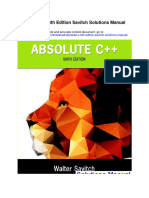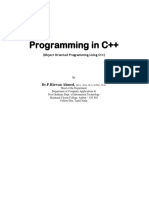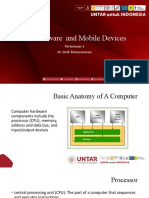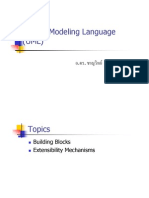Advanced PHP and Mysql: Course Syllabus
Advanced PHP and Mysql: Course Syllabus
Uploaded by
AbcCopyright:
Available Formats
Advanced PHP and Mysql: Course Syllabus
Advanced PHP and Mysql: Course Syllabus
Uploaded by
AbcOriginal Description:
Original Title
Copyright
Available Formats
Share this document
Did you find this document useful?
Is this content inappropriate?
Copyright:
Available Formats
Advanced PHP and Mysql: Course Syllabus
Advanced PHP and Mysql: Course Syllabus
Uploaded by
AbcCopyright:
Available Formats
COURSE SYLLABUS
Advanced PHP and MySQL
Industrial Training (3 MONTHS)
PH : 0481 2411122, 09495112288 Marette Tower
E-Mail : info@faithinfosys.com Near No. 1 Pvt. Bus Stand
Vazhoor Road
Changanacherry-01
www.faithinfosys.com
Target Audience
This course is specially designed for the B.Tech/B.E, M.Tech/M.E and
all other IT related Graduates and Post Graduate students who are interested in
learning web development using PHP framework.
Mission
Professionalism has conquered the job scenario and companies seek for
well qualified, professional and skilled manpower. Keeping in view this demand
of companies we groom students in such a way that they will be second to none.
Quality Education and Performance Oriented Training is our motto.
Course Overview
This course provides the necessary knowledge to design and develop
dynamic, data-driven & interactive web pages using PHP . It introduces
students to PHP framework and syntax, most important techniques used to build
dynamic web sites and perform hands on practice with a MySQL database to
create database-driven HTML forms. It is interspersed with step-by-step
exercises illustrating the concepts as they are explained.
Live Project Work
Live project is the phase when you finally implement most of the things
that you have learnt during your software training. Software development is
more than just coding. Before you write even a single line of code, it requires
careful analysis of the requirements, gathering information, preparing the
necessary documentation which requires understanding the live project using
Software Development Life Cycle. So you have to learn tricks to produce bulk
output on time maintaining the right design quality or coding standard. That is
the significance of Live Project Training. We assure that our Live Project
Training will impart the confidence in students to work on real time projects.
Add on Programs
Personality Development Topics Presentation
Listening Skills Awareness of IT Trends
Communication Skills Aptitude Tests
Interview Skills Technical Tests
Group Discussion Mock Interview
Faith Infosys Page 1
SOFTWARE ENGINEERING WITH UML
This course covers concepts of software engineering. It intends to lay a
foundation for software designing and professional practice by conveying
fundamental knowledge about software development process, requirements
analysis, design techniques, and testing methods. The course emphasizes on
modeling skills with the Unified Modeling Language(UML).
Section 1: Overview of Software Development
1.1 Software Engineering Concepts
1.2 Software Engineering Development Activities
1.3 System Development Models and Approaches
1.4 Software Process and Project Management
Section 2: Software Development Life Cycle
2.1 Requirement Elicitation
2.2 Analysis
2.3 System Design
2.4 Object Design
2.5 Implementation
2.6 Testing
Section 3: UML
3.1 Introduction
3.2 Need of UML
3.3 Use Case Driven Object Oriented Analysis
3.4 Use Case Model
3.5 Use Case Diagram
3.6 Activity Diagram
3.7 Sequence Diagram
3.8 Collaboration Diagram
3.9 Class Diagram
Section 4: Project Development Models
4.1 Waterfall
4.2 V model
4.3 Prototype model
4.4 Spiral model
Faith Infosys Page 2
WEB-SCRIPTING
Section 1: HTML - The Static Web Page Creation
1.1 The Head
1.2 The Body
1.3 Lists
1.4 Tables
1.5 Forms & Form Elements
1.6 Link
1.7 Images
1.8 Tag Attributes
Section 2: CSS - The Presentation Semantics
2.1 CSS Properties
2.2 Style Sheets
2.3 Styling with Classes
2.4 Styling with IDs
2.5 When to Use a Class and When to Use an ID
2.6 Linking to CSS in an External File
2.7 Using the style Attribute
Section 3: JavaScript - The Interpreted Programming Language
3.1 Interpreted Programming Languages
3.2 Integrating JavaScript with HTML
3.3 Variables in Javascript
3.4 Operators in Javascript
3.5 Expressions in Javascript
3.6 Arrays in Javascript
3.7 Handling Loops & Decision structures
3.8 Executing Conditional statements
3.9 Working with Functions
Section 4: Jquery - Write Less Do More…
4.1 Understanding jQuery
4.2 jQuery Selectors
4.3 Event Manipulation Methods
4.4 Sliding, Easing, Fading, Toggling
4.5 jQuery and AJAX calls
4.6 JSON
Faith Infosys Page 3
PROGRAMMING LANGUAGE (PHP-MySQL)
Course Description:
The contents of this course are a comprehensive solution that moulds you
to a PHP specialist by providing a combination of on hand labs and the training
provided in the class. It helps the trainee to learn and develop various php
technology applications that definitely meets the current industry needs.
Section 1: PHP – Understanding the Preliminaries.
1.1 Introduction to web & internet
1.2 Introduction to server
1.3 Understanding localhost server
1.4 Starting PHP
1.5 PHP syntax and variables
1.6 Operators and Expressions
1.7 Conditional Branching and Looping Statements
1.8 Learning Arrays in PHP
Section 2: PHP - The Core Logics and Techniques.
2.1 String and Math functions in PHP
2.2 Introduction HTML Form Elements and Fields
2.3 Accessing PHP, HTTP Data
2.4 Query Strings and Hyperlinks
2.5 Describing Pre-Defined Variables - Super Global Arrays
2.6 Understanding Functions, Important PHP Functions
2.7 What are the Scope of variables
2.8 Usage of Include and require statements
Section 3: PHP – File Handling. The Plain Repository of Data
3.1 Handling files and directories in PHP
3.2 Fetching information from files
3.3 Uploading and downloading files
Faith Infosys Page 4
Section 4: PHP and MySQL - The Structured Repository
4.1 PHP MySQL Connectivity
4.2 Integrating Web Forms and Database
4.3 Using PHP’s MySQL Extension
4.4 Using PHP’s PDO Extension
Section 5: Learn More Advanced Techniques in PHP
5.1 Introduction to Object Oriented Programming
5.2 Classes and Objects
5.3 Abstraction, Encapsulation, Inheritance and Polymorphism
5.4 Constructors and Destructors
5.5 Overloading, Overriding of functions
5.6 Exception Handling
5.7 Regular Expressions
5.8 Session Handling
5.9 Using Cookies
Section 6: Working with XML and JSON
6.1 Introduction to XML
6.2 How to Integrate PHP and XML
6.3 Introduction to JSON
6.4 Building a Sample Web Application
Section 7: Content Management Systems
7.1 Knowing Content Management System
7.2 Introducing a CMS
7.3 Knowing how to configure the CMS
7.4 Working with the CMS
7.5 Sample Web Application Development using Wordpress
Section 8: CodeIgniter Framework
8.1 Introduction to PHP Frameworks
8.2 Working with CodeIgniter Framework
8.3 MVC architecture in CodeIgniter
Faith Infosys Page 5
MySQL
Section 1: Relational Database Basics
1.1 Brief History of MySQL
1.2 Relational Databases and Popular Databases
1.3 SQL Statements
Section 2: Data Manipulation Language (DML)
2.1 INSERT
2.2 UPDATE
2.3 DELETE
2.4 SELECT
Section3: Data Definition Language (DDL)
3.1 CREATE
3.2 ALTER
3.3 DROP
Section4: Sub-Queries, Joins and Unions with MySQL
4.1 Order By, Like , And & Or, Where , Between
4.2 Joins & Unions
4.3 Aggregate Functions and Grouping
Section 5: Constraints and Normalization
5.1 Understanding Primary and Foreign Keys
5.2 Understanding Database Normalization
5.3 Views and Triggers
Faith Infosys Page 6
Live Project (The Mapping of what you learn…)
A software development process provides a basis for the organized
production of software, using a collection of predefined techniques and
notations. The process starts with the formulation of the problem, and then
continues through analysis, design and implementation.
Development Stages:
1. System Conception
Conceive an application and formulate tentative requirements. It
deals with genesis of an application.
2. Analysis
Analysis focuses on creation of models. It specifies what must be
done, not how it should be done. Developers must fully understand the
problem before addressing the additional complexities of design. During
analysis developers consider the available sources of information and
resolve ambiguities.
3. System Design
During system design, the developer makes strategic decisions
with broad consequences. The system designer must understand how a
new system interacts with other system, and the system must support
future modifications
4. Class Design
Developer expands and optimizes analysis models, there is a shift
in emphasis from application concepts toward computer concepts.
Developers choose algorithms to implements major system functions.
5. Implementation
Implementation is the stage for writing the actual code.
Developers map design elements to programming language and database
code.
6. Testing
During testing, Testers once again revisit the original business
requirements and verify that the system delivers the proper functionality.
It also uncovers the accidental errors that have been introduced.
**********************************
Faith Infosys Page 7
You might also like
- Architectural Manifesto: Designing Software Architectures, Part 5Document6 pagesArchitectural Manifesto: Designing Software Architectures, Part 5Felix R57% (7)
- Object ModelingDocument158 pagesObject ModelingDeny PrasetioNo ratings yet
- Tarkeshwar Barua - Mobile Applications Development - With Python in Kivy FrameworkDocument362 pagesTarkeshwar Barua - Mobile Applications Development - With Python in Kivy FrameworkSunnNightNo ratings yet
- Absolute C 6th Edition Savitch Solutions ManualDocument30 pagesAbsolute C 6th Edition Savitch Solutions ManualDavidKingprzaNo ratings yet
- Fundamentals of Python: First Programs Second EditionDocument42 pagesFundamentals of Python: First Programs Second EditionRendi WatulingasNo ratings yet
- CertificateDocument59 pagesCertificateHorror & Slasher MoviesNo ratings yet
- P3 Systems Design: User Interface Design Individual Exercise QuestionsDocument1 pageP3 Systems Design: User Interface Design Individual Exercise QuestionsJesylynn JpNo ratings yet
- Programming in C++ PDFDocument10 pagesProgramming in C++ PDFRizwan AhmedNo ratings yet
- Q2 MODULE1 G11 .NET PROG MangaldanNHSDocument8 pagesQ2 MODULE1 G11 .NET PROG MangaldanNHSJensen TagudinNo ratings yet
- Visual Basic ProjectDocument62 pagesVisual Basic ProjectRoshan RjNo ratings yet
- ASP.NetDocument126 pagesASP.NetGAMER HEADNo ratings yet
- Asp .Net MVC 4Document95 pagesAsp .Net MVC 4Sudhakar RaiNo ratings yet
- Chapter 31 Computer-Aided Software EngineeringDocument6 pagesChapter 31 Computer-Aided Software EngineeringRoshan KC100% (1)
- Latihan CRUD PHP NativeDocument10 pagesLatihan CRUD PHP NativeMelia SyuhadaNo ratings yet
- MSIT-102 Programming Concepts and CDocument218 pagesMSIT-102 Programming Concepts and CSaid kiranNo ratings yet
- 03.database Design ConceptsDocument45 pages03.database Design ConceptsJanaka SampathNo ratings yet
- TechnologyDocument408 pagesTechnologyAmy CraigNo ratings yet
- Tutorial IRM4724Document10 pagesTutorial IRM4724Sam GabrielNo ratings yet
- Web-Development ToC PDFDocument3 pagesWeb-Development ToC PDFRitik GuptaNo ratings yet
- Visual Basic Express GuideDocument89 pagesVisual Basic Express GuideToth CsabaNo ratings yet
- ACOM Chapter 7Document18 pagesACOM Chapter 7Ferl ElardoNo ratings yet
- Servlet QuestionsDocument6 pagesServlet QuestionskarunakarNo ratings yet
- PHP Programming Unit 5Document61 pagesPHP Programming Unit 5KumarNo ratings yet
- Programing Using C#Document2 pagesPrograming Using C#ml12783919No ratings yet
- MCQ LaravelDocument23 pagesMCQ LaravelUjjwal ShuklaNo ratings yet
- MKTG 201-Principles of Marketing-Sarah Suneel SarfrazDocument6 pagesMKTG 201-Principles of Marketing-Sarah Suneel Sarfrazhaiders youtubeNo ratings yet
- Q2 MODULE2 G11 .NET PROG MangaldanNHSDocument8 pagesQ2 MODULE2 G11 .NET PROG MangaldanNHSJensen TagudinNo ratings yet
- 1724084235-HandbookDocument414 pages1724084235-HandbookBaiuNo ratings yet
- Wordpress Workshop SyllabusDocument5 pagesWordpress Workshop SyllabusWilmer BeleñoNo ratings yet
- Larson PM 8e Ch04 ImDocument18 pagesLarson PM 8e Ch04 ImM S RameshNo ratings yet
- Mad Lab ManualDocument173 pagesMad Lab ManualPRIYA RAJI100% (2)
- Building Web Applications With: Course 977Document463 pagesBuilding Web Applications With: Course 977Adrian GorganNo ratings yet
- Hermans K. Mastering React Native. A Comprehensive Guide To Learn... 2023Document315 pagesHermans K. Mastering React Native. A Comprehensive Guide To Learn... 2023shermanNo ratings yet
- Overview of Software Engineering: VIT ChennaiDocument100 pagesOverview of Software Engineering: VIT ChennaiBharath BunnyNo ratings yet
- WebTechnology Syllabus 2021-22 (CBCS)Document2 pagesWebTechnology Syllabus 2021-22 (CBCS)Sulbha GathNo ratings yet
- GitHub ManualDocument18 pagesGitHub Manualabdulaziz450151677No ratings yet
- Standard Controls 2. Rich Controls 3. Validation Controls 4. Databind ControlsDocument26 pagesStandard Controls 2. Rich Controls 3. Validation Controls 4. Databind ControlsAli RajpootNo ratings yet
- Lecture 06 Software Maintenance PDFDocument14 pagesLecture 06 Software Maintenance PDFJONATHAN WABWIRE100% (1)
- Lect1 Intro To JavaDocument58 pagesLect1 Intro To JavaLương Tiến Dũng NguyễnNo ratings yet
- Simple Crud With PHP MysqliDocument13 pagesSimple Crud With PHP MysqliSania MinNo ratings yet
- University Employment Regulations For Non-Saudi Citizens: The Text of Higher Education Council Resolution Number 3/4/1417Document55 pagesUniversity Employment Regulations For Non-Saudi Citizens: The Text of Higher Education Council Resolution Number 3/4/1417Nurhazlinda MazlanNo ratings yet
- Lecture 5 - Conceptual, Logical & Physical DB DesignDocument68 pagesLecture 5 - Conceptual, Logical & Physical DB DesignAmmr Amn100% (1)
- CSIS 110 - Chapter 4Document82 pagesCSIS 110 - Chapter 4khattarNo ratings yet
- It8078 Web Design and Management MCQDocument124 pagesIt8078 Web Design and Management MCQkavi test100% (1)
- 16 ASP - Net Session23Document17 pages16 ASP - Net Session23vijaysharma24x7No ratings yet
- Chapter 8 - QuizDocument4 pagesChapter 8 - QuizPJ GapeNo ratings yet
- Creative Web Design ModulesDocument49 pagesCreative Web Design ModulesAldin AtezNo ratings yet
- Asp Net MVC 6 Changes Every Developer Should Know PDFDocument30 pagesAsp Net MVC 6 Changes Every Developer Should Know PDFRipperinaNo ratings yet
- Study Guide Ch04 TB StudentDocument7 pagesStudy Guide Ch04 TB StudentAlejandro Ramirez100% (2)
- Development of A Blog System Using Codeigniter Framework: Li YichengDocument60 pagesDevelopment of A Blog System Using Codeigniter Framework: Li YichengHammed Grayaa100% (1)
- Multithreaded Programming Using Java Threads: Praveenraj R (Mark Education Academy)Document46 pagesMultithreaded Programming Using Java Threads: Praveenraj R (Mark Education Academy)Rakesh. N murthyNo ratings yet
- Plantix Case Study 2 PDFDocument10 pagesPlantix Case Study 2 PDFanandNo ratings yet
- Quiz For Chapter 1 With SolutionsDocument6 pagesQuiz For Chapter 1 With SolutionsThọ LêNo ratings yet
- WordPress QuizDocument4 pagesWordPress Quizmurshad vinesNo ratings yet
- Hardware and Mobile DevicesDocument23 pagesHardware and Mobile Devicesagung darmawanNo ratings yet
- Modern Systems Analysis and Design: The Systems Development EnvironmentDocument33 pagesModern Systems Analysis and Design: The Systems Development EnvironmentKasyfiJohanNo ratings yet
- Programming Fundamental All ChapterDocument265 pagesProgramming Fundamental All ChapterKran Kumar100% (1)
- Git & GitHub QuizDocument3 pagesGit & GitHub QuizBright StarNo ratings yet
- Complete JAVA: Course SyllabusDocument14 pagesComplete JAVA: Course SyllabusRajaNo ratings yet
- Course OutlineDocument3 pagesCourse Outlinegulelat.atuuNo ratings yet
- Event-Driven Programming 240930 142125Document3 pagesEvent-Driven Programming 240930 142125abiysol95No ratings yet
- MTA 98-361 OutlineDocument3 pagesMTA 98-361 OutlineParshu RamNo ratings yet
- Object-Oriented Systems DevelopmentDocument64 pagesObject-Oriented Systems DevelopmentnootiNo ratings yet
- Ooad UNIT 5 NotesDocument29 pagesOoad UNIT 5 NotesplutopopNo ratings yet
- UML Part2Document23 pagesUML Part2kareem AymanNo ratings yet
- Report of Student Management SystemDocument55 pagesReport of Student Management SystemKunal BangarNo ratings yet
- OOSE Lecture 1Document27 pagesOOSE Lecture 1018 ChhaviNo ratings yet
- Project Hospital ManagementDocument55 pagesProject Hospital ManagementDeepak YadavNo ratings yet
- 405course File OOPSDocument52 pages405course File OOPSAshish RanjanNo ratings yet
- OOAD Question PapersDocument206 pagesOOAD Question PapersManjunathaSwamyU0% (1)
- Ch-2 UML EdittedDocument73 pagesCh-2 UML EdittedMintesnot AbebeNo ratings yet
- Online Job Portal Java Project DocumentDocument92 pagesOnline Job Portal Java Project DocumentMamatha RYNo ratings yet
- Chapter 1: Introduction: Objectives of The ClassDocument9 pagesChapter 1: Introduction: Objectives of The ClassLouegi Dy GastonNo ratings yet
- Rapid Application DevelopmentDocument7 pagesRapid Application DevelopmentMohammad FawadNo ratings yet
- Book BankDocument10 pagesBook Bank02 - Adwin PrajishaNo ratings yet
- Price List January 2023Document118 pagesPrice List January 2023VipulPrajapatiNo ratings yet
- Assignment Brief Unit 20 Advanced Programming Sep 2022Document2 pagesAssignment Brief Unit 20 Advanced Programming Sep 2022Norez BaberNo ratings yet
- OCUP2 FoundationDocument3 pagesOCUP2 FoundationdonothingaccountNo ratings yet
- Conference Management System (UML Sequence and Collaboration Diagram)Document12 pagesConference Management System (UML Sequence and Collaboration Diagram)Siva siva100% (2)
- Chapter 4Document5 pagesChapter 4tanyaradzwadhliwayo002No ratings yet
- CS504 Software Engineering-1 2011 Mid Term Mcqs Solved With References by MoaazDocument16 pagesCS504 Software Engineering-1 2011 Mid Term Mcqs Solved With References by MoaazShahrukh Usman100% (1)
- Lesson 5 Information System DevelopmentDocument15 pagesLesson 5 Information System DevelopmentDominic Dave Davin EmboresNo ratings yet
- UML Reference Sheet PDFDocument5 pagesUML Reference Sheet PDFRamkumar DNo ratings yet
- Video Lib Management SystemDocument8 pagesVideo Lib Management SystemAnand Mohan Singh SuryavanshiNo ratings yet
- IELM 511: Information System Design: Part 1. ISD For Well Structured Data - Relational and Other DBMSDocument15 pagesIELM 511: Information System Design: Part 1. ISD For Well Structured Data - Relational and Other DBMSnikunjpatel90No ratings yet
- Role Engineering: From Design To Evolution of Security SchemesDocument21 pagesRole Engineering: From Design To Evolution of Security SchemesJuan RedesNo ratings yet
- Chapter 6: Questions and AnswersDocument51 pagesChapter 6: Questions and Answersnnbphuong810% (2)
- RWR IFC - Rail Context ApproachDocument17 pagesRWR IFC - Rail Context Approachthongnt.mrbNo ratings yet
- Object Oriented ProgrammingDocument2 pagesObject Oriented Programmingprince_kc2002No ratings yet
- Unified Modeling Language (UML)Document84 pagesUnified Modeling Language (UML)Chanwit KaewkasiNo ratings yet

























































































